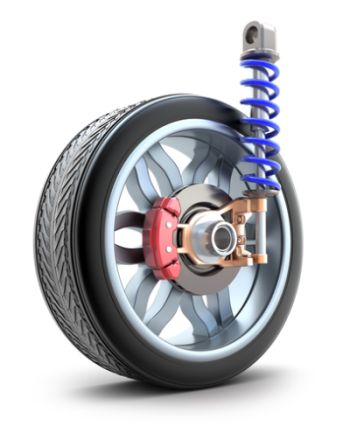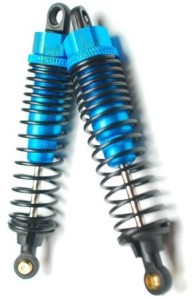What are shock absorbers? Well they’re a range of sports bra for a start, but that’s a different blog altogether.
More accurately, for our purposes, they are the tubular metal devices filled with hydraulic fluid and fitted to each of your car’s wheels to help absorb the impact of bumps and holes in the road surface.
Along with smoothing out bumps and vibrations, the key role of the shock absorbers is to ensure that the vehicle’s tyres remain in contact with the road surface at all times, which ensures the safest control and braking response from your car.
 In fact it’s the suspension springs which absorb the hit when your tyre runs over a bump or a pothole, but if you didn’t have shock absorbers fitted your car would wallow about like a jelly every time you went round a corner or encountered an uneven road.
In fact it’s the suspension springs which absorb the hit when your tyre runs over a bump or a pothole, but if you didn’t have shock absorbers fitted your car would wallow about like a jelly every time you went round a corner or encountered an uneven road.
The springs allow the car’s wheels to ride up and down over potholes, but it’s the shock absorbers that stop the springs from continuing to bounce around like, well, springs. The combination of shock absorbers and springs also works to enable the car to take corners without wallowing.
Getting a perfect balance between spring and shocks is the goal of every car maker. Stiffer springs and shocks allow for faster cornering and a more sporty feel, a softer setup tends to mean more comfortable day-to-day driving.
Driving a car with no shock absorbers would be more like sailing than driving, and you and your passengers would be seasick after a few miles. On the other hand a broken shock absorber can cause that corner of your car to “stiffen up”, and lead to poor handling and a noticeably rough ride.
Types of shock absorbers
Although all shock absorbers do the same job, the different suspension designs favoured by different manufacturers mean the shocks they use can be different too, although they fall into 3 categories:
- Conventional telescopic shock
- absorbers – the simplest type of shock absorber, found on both front and rear suspension systems. They are relatively inexpensive and simply replaced when they fail.
- Strut-type shock absorbers – these replace part of the suspension system and so are more ruggedly built to handle the loads placed on them during driving. These shock absorbers can be either sealed or repairable units.
- Spring seat shocks – this type is an all-in-one suspension unit and damping device. Built using similar components to conventional shock absorbers, spring seat shocks are also sealed requiring full replacement when they wear out.
Why do shock absorbers need to be changed?

Shock absorbers use hydraulic fluid to dampen the rebound of the suspension springs when you drive over a bump or hole. They do a lot of work on every journey and inevitably will wear out. How quickly they wear out will depend as always on the build quality and the type of driving you do; driving over rougher terrain, or sporty driving with lots of hard cornering, will cause them to wear more quickly.
A good shock absorber also prolongs the life of other suspension parts and drive systems such as the springs and tyres, so early repair or replacement is usually a good investment to prevent further bills.
What happens if they are not changed?
If your shock absorbers fail your car will be very unstable and difficult to drive. A worn or leaking shock absorber can affect the safety of your braking and handling, so they are checked as part of every MOT. If any one isn’t working correctly we tell you it should be replaced.
A simple test you can do yourself is to bounce each corner of your car by leaning hard on it and letting go suddenly. It should bounce back once and then settle. If it bounces up and down a few times before settling, it’s probable the shock has failed. If it doesn’t bounce back at all, and/or makes creaking noises when you lean on it, then it’s worth having the suspension checked; there could be a problem with the shock absorber being seized up, or the springs, or the suspension mounts that attach everything together.
